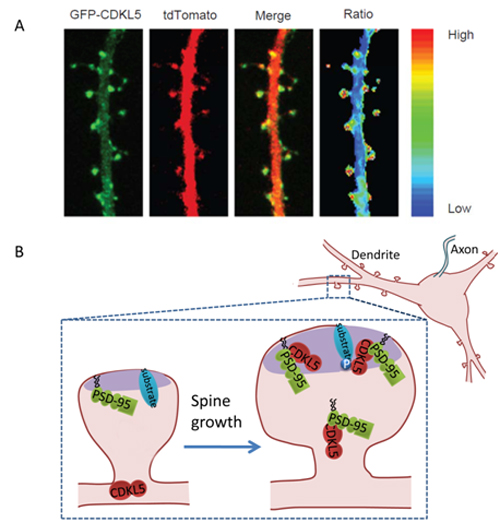Time:2013-05-14
On May 13, 2013, a study from the Laboratory of Neurobiology of Diseases at the Institute of Neuroscience, Chinese Academy of Sciences, was published online in PNAS as a research article entitled “Palmitoylation-dependent CDKL5–PSD-95 interaction regulates synaptic targeting of CDKL5 and dendritic spine development”. This work was mainly carried out by graduate students Yong-Chuan Zhu and Dan LI under the supervision of Dr. Zhi-Qi Xiong.
Mental retardation is a severe neurological disorder affecting 1-3% of total population. Most of the profound mental retardation is caused by genetic factors. By studying the function of mental retardation genes, it is likely to gain important insights into the pathogenesis of cognitive disorders and the development of the brain. Mutations in the X-linked gene CDKL5 have been identified in patients with severe mental retardation and Rett syndrome-like disorders. However, the function of CDKL5 in neuronal development is not clear. Yong-Chuan Zhu, Dan Li, and colleges found that CDKL5 is predominantly expressed in the brain and is enriched in excitatory synapse. They searched for the interacting partners of CDKL5 in synapse by an affinity protein purification combined with mass spectrometry and identified the scaffolding protein postsynaptic density 95(PSD-95), an important regulator of synapse development. They found that CDKL5 does not consecutively form a complex with PSD-95, but only binds to palmitoylated PSD-95. Palmitoylation is a lipid modification that targets PSD-95 to synapse, and this palmitoylation-dependent CDKL5–PSD-95 interaction promotes the synaptic accumulation of CDKL5. Interestingly, pathogenic mutations that truncate the C-terminal tail of CDKL5 diminish its binding to PSD-95 and its synaptic targeting. Finally, they demonstrated that the targeting of CDKL5 in synapse via interaction with palmitoylated PSD-95 is important for synapse formation and maturation.
These results point to a synaptic mechanism for CDKL5-related disorders and suggest a pathological mechanism for CDKL5 mutations. Future direction will be to study the synaptic function of CDKL5 in depth and identify substrates of CDKL5 in synapse.
This work was supported by grants from 973 Program, National Natural Science Foundation of China, and Program of Shanghai Subject Chief Scientist.

A.Enrichment of GFP-CDKL5 in dendritic spines of cultured hippocampal neurons.
B.Working model: palmitoylated PSD-95 binds to and promotes the synaptic targeting of CDKL5 for spine growth and maturation.
 附件下载:
附件下载: